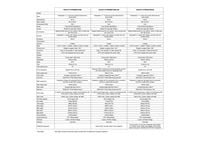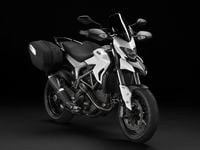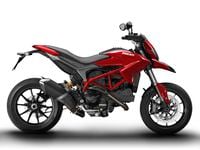Ducati has comprehensively updated the Hypermotard line for 2013 by shoehorning in a version of the Testastretta 11-degree engine, offering two specifications of the main model, and adding something called the Hyperstrada, a distance-worthy model likely to be known as the mini-Multi for its resemblance to the full-size Multistrada. (KTM fans might also call it an Italian SM-T.)
All Hypermotards come standard with the Ducati Safety Pack consisting of ABS and Ducati Traction Control. All three also benefit from three riding modes: Sport, Touring, and Urban for the Hyper and Hyperstrada, and Race, Sport, and Wet for the Hyper SP. Riding modes alter throttle response and will limit power in the Urban/Wet settings; they also change ABS and TC thresholds.
Power fixes everything. Ducati’s Hypermotard did just fine with the old two-valve, air-cooled engine but came to be overshadowed by the intensely powerful Streetfighter on the adrenaline-crazed end and by the Multistrada in venues where versatility was valued.
It's safe to say the Hyper has stepped out of the shadows. For 2013, Ducati has fitted it with an 821cc version of the Testastretta 11-degree engine—a four-valve, liquid-cooled, near-superbike powerplant that should push aside devotion to the old desmodue engine. In this displacement, the engine makes a respectable 110 crank horsepower and 65.8 lb.-ft. of torque, according to Ducati. That's 30 bhp down on the 848 Evo, but nearly the same in terms of torque, which peaks an amazing 2000 rpm lower than on the superbike. As Ducati did with the 11-degree engine variant in the Multistrada, tuning for torque and a wide powerband took precedence over peak power. The Hyper's engine has a different bore/stroke ratio than the 848's—88 x 67.5mm for the 821cc engine versus 94 x 61.2mm—and features smaller valves, a lower compression ratio (12.8:1 instead of 13.2:1), and various other tuning tricks to strengthen midrange power, says Ducati. The company is particularly proud of the extended valve-check interval, which is now 30,000 km (18,641 miles).
A fresh steel-tube trellis frame holds the new engine, and supports uprated suspension components, a larger fuel tank (now 4.2 gallons), and updated styling. The base Hypermotard gets a non-adjustable Kayaba fork and Sachs shock with adjustable spring preload and rebound damping. An SP version upgrades to a Marzocchi fork with aluminum sliders and full damping adjustment and an Ohlins piggyback shock; both ends of the SP have 15mm more travel front and rear. Forged wheels replace cast items on the SP.
The Hyperstrada has the same style of suspension as the base Hyper but with fork travel reduced by 20mm, but that’s just the beginning of the changes. These start with a new windscreen and a revised, touring-oriented seat; both of which are available from Ducati Accessories and will fit the other versions of the Hypermotard. (A 20mm-lower accessory seat will be available, too.) Handlebars raised 20mm over the standard Hyper also helps with the long-distance thing. Quick-detach, 50-liter (total) saddlebags come standard, while an accessory top case will be available. The Hyperstrada even comes with a centerstand. At 450 pounds wet, the Hyperstrada is 22 lbs. heftier than the Hyper SP, 13 chunkier than the base Hypermotard.
Pricing for the Hypermotard starts at $11,995, continues to $13,295 for the Hyperstrada, and concludes at $14,695 for the Hyper SP.














/cloudfront-us-east-1.images.arcpublishing.com/octane/TNOU5DNE2BC57MFPMGN2EIDXAM.jpg)
/cloudfront-us-east-1.images.arcpublishing.com/octane/GTCXACQGJ5HAPDTGWUQKDEH44E.jpg)
/cloudfront-us-east-1.images.arcpublishing.com/octane/S35YGSEMEZB4BLTDJTSZPF4GLA.jpg)
/cloudfront-us-east-1.images.arcpublishing.com/octane/5UOT6HPX2JFMRJAX6EH45AR4MQ.jpg)
/cloudfront-us-east-1.images.arcpublishing.com/octane/OKWOJWAKP5EP3OACCRRWPCIX2Q.jpg)
/cloudfront-us-east-1.images.arcpublishing.com/octane/2WF3SCE3NFBQXLDNJM7KMXA45E.jpg)
/cloudfront-us-east-1.images.arcpublishing.com/octane/G4MG6OUCJNBSHIS2MVVOTPX65E.jpg)
/cloudfront-us-east-1.images.arcpublishing.com/octane/IIGGWFOTOJGB7DB6DGBXCCMTDY.jpg)
/cloudfront-us-east-1.images.arcpublishing.com/octane/QSTCM6AVEZA5JJBUXNIQ3DSOF4.jpg)
/cloudfront-us-east-1.images.arcpublishing.com/octane/U4I7G625B5DMLF2DVIJDFZVV6M.jpg)
/cloudfront-us-east-1.images.arcpublishing.com/octane/B6XD6LS6IVCQPIU6HXDJSM3FHY.jpg)
/cloudfront-us-east-1.images.arcpublishing.com/octane/ICL63FEDDRDTTMINYICCEYGMDA.jpg)
/cloudfront-us-east-1.images.arcpublishing.com/octane/FCGZHQXRBZFLBAPC5SDIQLVF4I.jpg)
/cloudfront-us-east-1.images.arcpublishing.com/octane/WNOB6LDOIFFHJKPSVIWDYUGOPM.jpg)

/cloudfront-us-east-1.images.arcpublishing.com/octane/X33NU3E525ECRHXLNUJN2FTRKI.jpg)
/cloudfront-us-east-1.images.arcpublishing.com/octane/6KKT5NNL2JAVBOXMZYS5ZO76YA.jpg)
/cloudfront-us-east-1.images.arcpublishing.com/octane/J5RKG5O455GMPGQRF2OG6LRT7A.jpg)
/cloudfront-us-east-1.images.arcpublishing.com/octane/GX2CIZKQVRH2TATDM26KFG2DAE.jpg)
/cloudfront-us-east-1.images.arcpublishing.com/octane/ZWIDYSAKQZHD5BHREMQILXJCGM.jpg)
/cloudfront-us-east-1.images.arcpublishing.com/octane/CYUHJZCTSJCH3MRAQEIKXK7SCQ.jpg)
/cloudfront-us-east-1.images.arcpublishing.com/octane/LKOFINY56FCXJCANJ5M7ZDQUBY.jpg)
/cloudfront-us-east-1.images.arcpublishing.com/octane/4NBPDACMWJH63JQYJVK3QRBDZI.jpg)
/cloudfront-us-east-1.images.arcpublishing.com/octane/KKHQHRR3FJGX7H2IPU6RALMWG4.jpg)